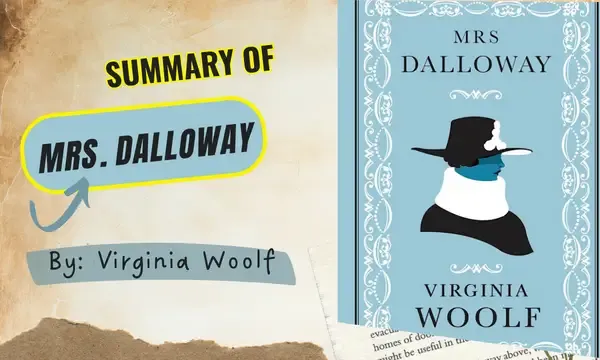The main theme of Mrs. Dalloway is the exploration of inner lives, thoughts, and consciousness of individuals as they navigate the complexities of social norms and personal identity in post-World War I England.
 |
| Summary of Mrs. Dalloway by Virginia Woolf |
The general idea of Mrs. Dalloway
The fluidity and interconnectedness of human consciousness: Woolf employs stream-of-consciousness narrative techniques to delve into the minds of her characters, revealing their inner thoughts and emotions.
The impact of social expectations on personal identity: The characters in the novel grapple with societal pressures and conventions, often suppressing their true desires and conforming to social expectations.
The effects of war and trauma: The aftermath of World War I is depicted through the lens of characters who bear the scars of the war, highlighting its profound impact on individuals and society as a whole.
About the writer of Mrs. Dalloway's book
Virginia Woolf was a prominent British modernist writer, known for her innovative literary techniques and exploration of feminist and psychological themes. She was a key figure in the Bloomsbury Group, an influential collective of writers and intellectuals in early 20th-century London. Woolf's own experiences with mental health and her critical observations of societal norms inform her writing.
Read more:
Summary of Black Beauty by Anna Sewell
Summary of Oliver Twist by Charles Dickens
Chapters of Mrs. Dalloway
Part I: "Mrs. Dalloway Said She Would Buy the Flowers Herself"
This opening section introduces the protagonist, Clarissa Dalloway, a middle-aged woman preparing for a party she will host that evening. The chapter establishes the atmosphere of London, the setting where the story unfolds, and provides glimpses into Clarissa's past and her reflections on life.
Part II: "Mrs. Dalloway Decides to Buy the Flowers Herself"
In this section, the narrative shifts between various characters, including Peter Walsh, Clarissa's former suitor, and Septimus Warren Smith, a shell-shocked war veteran. Through their perspectives, the novel explores themes of love, regret, and the impact of war on individuals' mental states.
Part III: "The Flashback; Miss Kilman; Rezia; Septimus"
This chapter delves into Septimus Warren Smith's deteriorating mental state and his relationship with his wife, Lucrezia. It explores the traumatic effects of war on soldiers and the challenges faced by those suffering from mental illness.
Part IV: "Mrs. Dalloway, Septimus and Clarissa"
The final section brings together the parallel narratives of Clarissa Dalloway and Septimus Warren Smith. While preparing for her party, Clarissa senses a connection to Septimus' despair, reflecting on the contrast between the outer façade of society and the inner struggles of individuals.
Conclusions of Mrs. Dalloway
- The novel underscores the importance of understanding and empathizing with the inner lives of others.
- Society's expectations and the fear of judgment can stifle personal fulfillment and authenticity.
- The lasting effects of war on individuals' mental health and the need for compassionate treatment of trauma victims.
Mrs. book Dalloway for other books
Mrs. Dalloway can be compared to other modernist novels, such as James Joyce's Ulysses and William Faulkner's The Sound and the Fury, which similarly employ stream-of-consciousness techniques to delve into characters' inner lives and explore the complexities of human consciousness.
The audience of Mrs. Dalloway
The book is primarily targeted towards readers interested in modernist literature, character-driven narratives, and introspective explorations of human psychology. It appeals to those who appreciate lyrical prose and innovative narrative techniques.
The date of publication of Mrs. Dalloway
Mrs. Dalloway was published by Hogarth Press in 1925.
Recommendations for other books
- "To the Lighthouse" by Virginia Woolf: Another notable work by the same author, it further explores themes of consciousness, memory, and the complexities of human relationships.
- "Ulysses" by James Joyce: This groundbreaking modernist novel employs stream-of-consciousness techniques to depict a single day in the life of its characters, delving into their thoughts, desires, and experiences.
- "The Sound and the Fury" by William Faulkner: Like Mrs. Dalloway, this novel employs multiple perspectives and explores the fragmented nature of consciousness and the consequences of societal expectations.
To sum up: Mrs. Dalloway offers a lyrical and introspective exploration of human consciousness, societal expectations, and the enduring impact of war, all conveyed through innovative narrative techniques and the inner lives of its characters.
